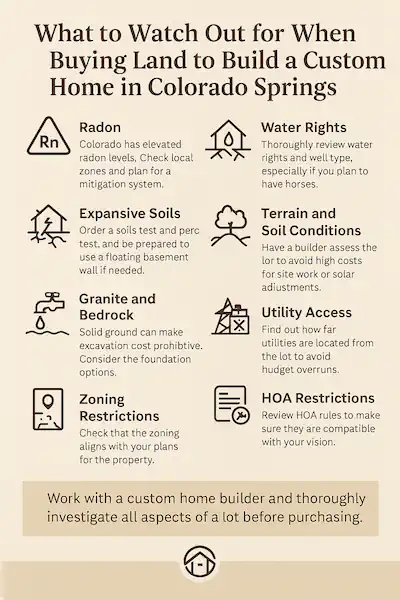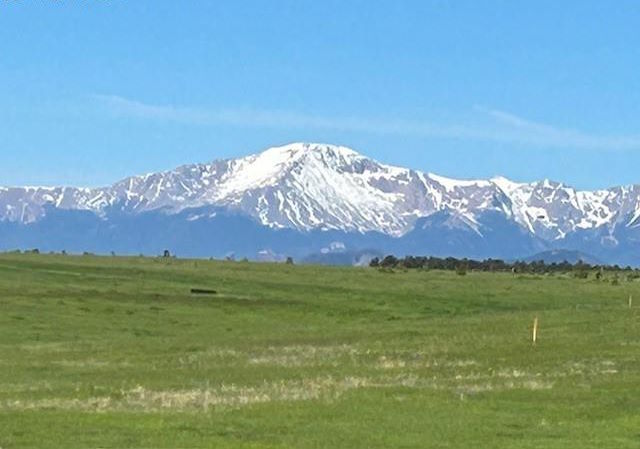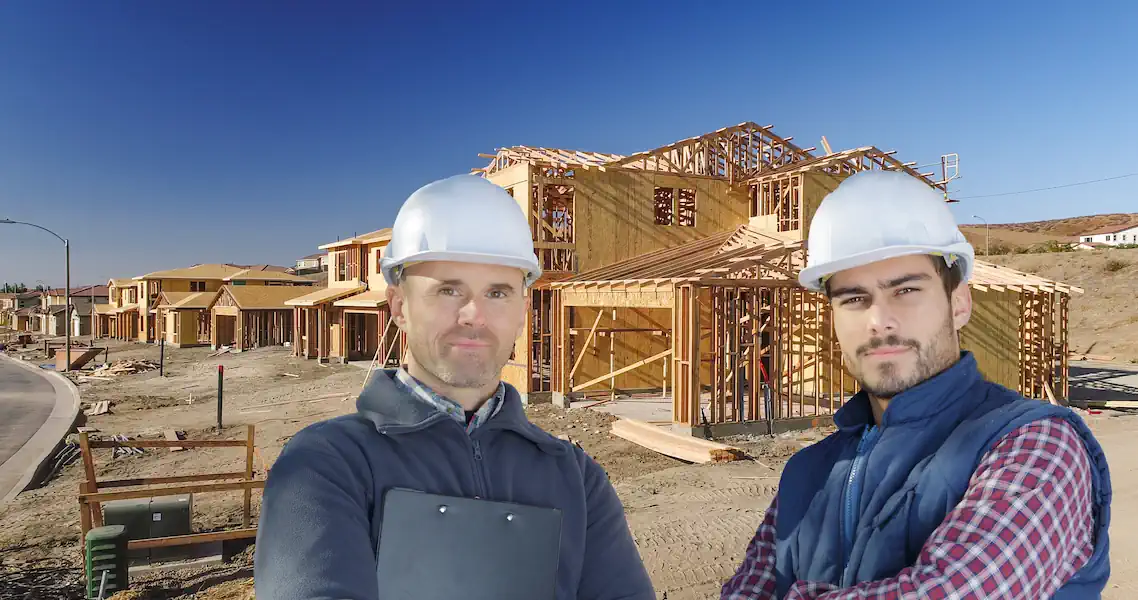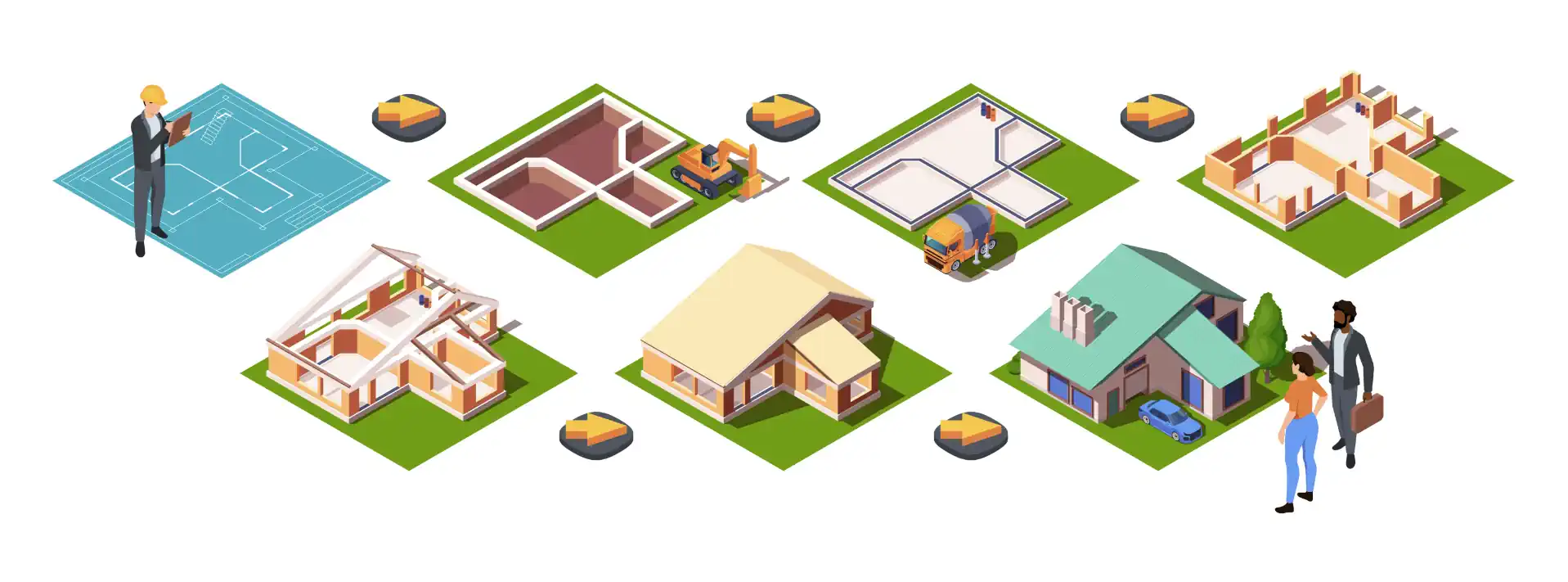If you are planning to build a custom home in Colorado Springs and have never purchased land before you’ll need to know about some unique things to consider before buying the land. In this area, the region’s terrain, soil conditions, water rights, and geological factors can impact your plans in ways you might not expect. As a Colorado Springs Custom Home Builder we've seen many different issues with land. That's why we've put together this list of 14 Things to Know Before Buying Land for Your Colorado Springs Custom Home.
 Zoning Restrictions: Know the Rules
Zoning Restrictions: Know the Rules
In Colorado Springs as in many places around the country, every piece of land is subject to zoning restrictions. These rules control what you can build, how large the structure can be, and what type of activities are allowed on the property.
If you plan to add an accessory dwelling unit, operate a business from home, or build a large shop or barn, verify the zoning supports it. The seller should be able to tell you what the land is zoned but you should also do your own research. Colorado Springs zoning office can provide maps and guidance to help you understand the rules that apply to the property.
HOA Restrictions: Read the Fine Print
Many Colorado Springs-area communities have homeowners associations (HOAs) that enforce architectural standards and property use rules. These can affect everything from fencing and paint colors to driveway materials and landscaping.
Before you buy, ask for a copy of the HOA’s covenants, conditions, and restrictions (CC&Rs). Make sure the community’s rules align with your vision. Some HOAs are lenient, but others are highly restrictive and can limit your design choices.
Utility Access: Don’t Let Distance Surprise You
Check where the nearest connections for electric, gas, water, sewer, and internet are located. If they are far from your lot, you could face unexpected expenses to bring them in.
Some rural lots require a septic system and a propane tank. Others might need long trenches to connect to existing utilities. The longer the trench, the higher the cost. Always ask for estimates so you can compare lots accurately, even if the price per acre looks good on paper.
Water Rights: Never Take Them for Granted
In Colorado, water rights are complex and critically important. Not every parcel comes with the legal right to access ground water. Some properties get water from the city. Some get their water from a community well or Metropolitan District, and some may require you to drill a well. Its important to note that not all areas allow new wells.
That being said, there are two primary types of residential wells in Colorado: household-use-only wells and domestic-use wells. A household-use-only well permits water for basic indoor use, such as drinking, bathing, and washing. A domestic-use well is more flexible and may allow for limited outdoor use, including watering a garden or livestock.
If you plan to have horses or other animals on your property, it’s essential to verify whether the type of well you are permitted to drill will allow you to legally water those animals. Don’t assume livestock use is automatically included even if you see horses on the property next door.
Before you buy, confirm whether the lot has a municipal water tap or the legal right to drill a well. Review the specific well type and any restrictions that apply. Ask the seller if they already have a well permit. A well permit must be obtained through the Colorado Division of Water Resources, and there are regulations that vary depending on whether the use is for household-only or also includes irrigation or livestock. These details can significantly affect how you use the land and what kind of lifestyle you can enjoy once you build.
Land Requirements for Septic Systems
If you're buying land in an area without access to municipal utilities, you'll likely need to install a septic system also. Septic systems come with specific site requirements and permitting processes, and not every lot qualifies.
For a septic system, the land must pass a percolation (perc) test. This measures how quickly soil absorbs water and determines whether a septic system can safely function on the property. The El Paso County Public Health Department oversees the permitting and design approval for onsite wastewater treatment systems.
Septic systems also require adequate space. Typically, at least one acre is recommended to allow for proper setback distances from wells, septic fields, property lines, and neighboring wells. Steep slopes, rocky soil, or high water tables can make installation difficult or even impossible.
Before purchasing land that will require a well and septic system, make sure both the soils and perc tests are completed and reviewed. These tests can make or break your ability to build and should be done before closing.
Easements: Know Who Has Access to Your Land
An easement is a legal right for someone else to use a portion of your property for a specific purpose. Easements can be granted for utilities, shared driveways, access roads, drainage, or even walking paths. While they don’t necessarily stop you from building, they can limit where and how you build.
For example, if there’s an underground utility easement running through the center of your lot, you won’t be able to place a foundation over it. You may also be required to allow access for utility work in the future.
Before closing on a piece of land, it’s important to obtain either a survey or an Improvement Location Certificate (ILC). These documents show boundary lines, easements, and existing improvements. A full survey is more detailed, but even an ILC can reveal potential conflicts or limitations that could impact your building plans.
Terrain and Soil Conditions: The Ground Matters
Depending on the type of home you want to build, the terrain is important. To build a walk-out or garden-level basement you’ll need a sloped lot. Sloped lots, rocky outcrops, or drainage issues can require special foundation engineering, grading, or retaining walls.
Even flat lots should not be assumed to be build-ready. Soil conditions can vary significantly even within the same neighborhood. You also can't assume that just because the land is flat, you can place the house exactly where you want. Setbacks, soil conditions, and terrain features may limit where and how the home can be positioned.
If you're considering solar panels, orientation is critical. You’ll want a builder to walk the lot and determine whether the home can be positioned to maximize sun exposure. Trees, neighboring homes, and hillsides can block sunlight, even on open or flat land. Planning for solar from the beginning helps avoid costly adjustments later and ensures you get the full benefit of your system.
Expansive Soils: Small Shifts with Big Consequences
Colorado’s Front Range is well known for its expansive clay soils. These soils swell when they absorb moisture and shrink when they dry out, causing the ground to shift. That movement puts pressure on foundations, driveways, and basement walls, often resulting in cracks or structural damage over time.
Because of this, a soils test is required in Colorado Springs before building. The report evaluates the type of soil on the lot and helps determine how the foundation should be engineered. Based on the results, an engineer will develop a plan that ensures the home is built to withstand the soil conditions. For example, if the lot is full of clay, the engineer may require the unsuitable soil to be dug out and replaced with compacted, non-expansive fill. This process helps create a more stable base for the foundation.
In addition, Colorado Springs building codes require floating basement walls for all homes because of the expansive soils. These walls are constructed with a gap at the bottom so they can move independently of the floor slab, preventing cracks or structural issues when the ground shifts. The floor slab may still crack but the walls and the upper levels will not.
Before closing on a piece of land, a soils test should be ordered. The soils tests provide critical information about the site's buildability and can reveal costly conditions before you're locked into a purchase.
Granite and Bedrock: Beautiful but Challenging
Speaking of costly conditions, lots that sit on granite or solid bedrock may look like any other lot at first glance. You may just see dirt. But, underneath that dirt can be solid bedrock. Solid ground like this can make excavation cost-prohibitive. It takes more time, specialized equipment, and adds significantly to the overall construction budget.
While it’s not impossible to build on land with bedrock, you’ll likely be building up, not down. Full basements are often out of the question, and slab-on-grade or crawl space foundations become the more feasible options. If you’ve dreamed of a walkout basement or extra storage below grade, this kind of lot might not support those plans without major cost increases.
Land Subsidence: Avoid Sinking Surprises
Land subsidence is the gradual sinking of the ground and can be caused by underground erosion, old mining activity, or natural soil movement. Colorado Springs has a history of subsidence, particularly in areas with abandoned mines.
Before purchasing land, it’s a good idea to check the Abandoned Mines Map. This interactive tool helps you identify whether a parcel is near old mine tunnels or shafts. Knowing what lies beneath your property is essential for avoiding future problems.
Landslides: A Hidden Risk in Steep Terrain
If you’re drawn to the hillsides and slopes around Colorado Springs, be aware of landslide risk. The region includes several areas that are geologically active or have a history of slope instability.
Before purchasing, review the Colorado Geological Survey’s Landslide Areas Map. This resource identifies locations prone to landslides or where landslides have occurred. It is not all inclusive in that there are areas that could be prone to landslides that are not on the map. However, knowing where they've occurred in the past can help you avoid costly surprises and can influence your design and grading plan.
Wildfire Risk: Plan for Safety
Colorado’s dry climate and forested terrain mean that wildfire risk is a real concern in certain areas. Black Forest, Palmer Lake, and the foothills west of town have all experienced fires in recent years.
If the lot you are considering is in a wildfire-prone zone, you will need to incorporate defensible space, fire-resistant materials, and access for emergency vehicles into your design. You will also want to check with your insurance provider about coverage and rates in high-risk areas. You can get more information about Wildfire Planning from the Colorado Springs Fire Department.
Radon: The Invisible Health Risk
Radon is a naturally occurring radioactive gas that seeps up from the ground. It is invisible and odorless but can pose serious health risks if it accumulates inside a home. Colorado, including El Paso County, is known for elevated radon levels. In fact, 40% of all tests done have shown high levels of radon. Its almost impossible to escape radon but it is not impossible to mitigate it. A radon mitigation system doesn’t cost much, usually $1500 or less. So just plan for it.
Accessibility and Road Conditions: Year-Round Usability Matters
Some lots are accessed by gravel or unimproved roads, especially in rural areas. During the winter months, these roads can become difficult or even impossible to navigate without a four-wheel-drive vehicle. Even paved roads when it snows can require four-wheel drive.
Find out who is responsible for road maintenance and whether snow removal is provided. Poor access can delay construction, raise insurance costs, and create problems for deliveries and emergency services.
Final Thoughts: A Little Research Goes a Long Way
Buying land for a custom home in Colorado Springs opens the door to endless possibilities, but it also requires careful planning. From soil testing and zoning to access and orientation, every step you take before purchasing land helps ensure that your dream home is built on a strong and stable foundation.
Work with a trusted custom home builder who knows the local area. Ask questions, review reports, and get clarity on every aspect of the lot before closing. When you do your homework, you can move forward with confidence.



